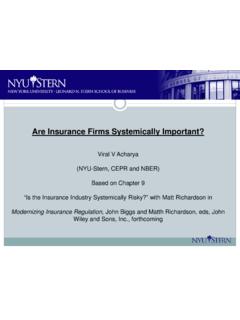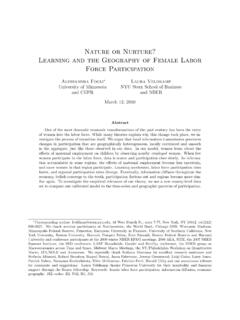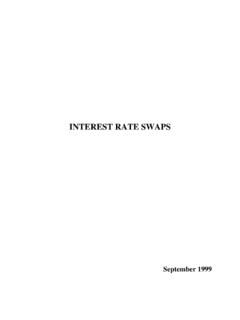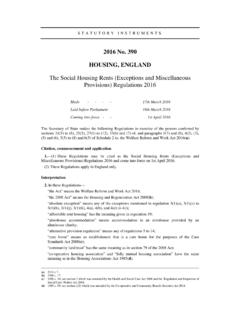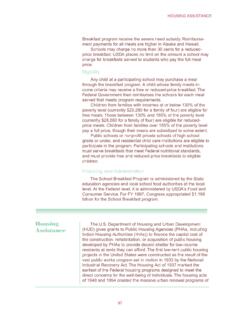Transcription of The Economic Effects of Social Networks: Evidence from the ...
1 The Economic Effects of Social Networks: Evidence from the housing MarketMichael BaileyFacebookRuiqing CaoHarvard UniversityTheresa KuchlerNew York UniversityJohannes StroebelNew York University, National Bureau of Economic Research, and Centrefor Economic Policy ResearchWe show how data from online Social networking services can help re-searchers better understand the Effects of Social interactions on eco-nomic decision making. We combine anonymized data from Facebook,the largest online Social network, with housing transaction data and ex-plore both the structure and the Effects of Social networks. Individualswhose geographically distant friends experienced larger recent houseprice increases are more likely to transition from renting to also buy larger houses and pay more for a given house.
2 Survey datashow that these relationships are driven by the Effects of Social interac-tions on individuals housing market paper was previously circulated as Social Networks and housing Markets. For help-ful comments, we are grateful to Alex Chinco, Tony Cookson, Eduardo Davila, AnthonyDeFusco, Giovanni Favara, Andreas Fuster, Marty Eichenbaum, Xavier Gabaix, Pedro Gete,Stefano Giglio, Adam Guren, Ben Golub, Harrison Hong, Erik Hurst, Ben Keys, AndresElectronically published October 30, 2018[Journal of Political Economy, 2018, vol. 126, no. 6] 2018 by The University of Chicago. All rights reserved. 0022-3808/2018/12606-0001$ content downloaded from on November 21, 2018 12:54:36 PMAll use subject to University of Chicago Press Terms and Conditions ( ).
3 Researchers are increasingly interested in studying the Effects of interac-tions through Social networks on Economic decision making. However,analyzing the Economic Effects of Social interactions has proved challeng-ing, in large part because of the absence of high-quality data on Social net-works that can be linked to outcome variables of interest. In this paper, weshow how data from online Social networking services such as Facebookand LinkedIn can help overcome this measurement challenge, with thepotential to dramatically expand our understanding of the role of socialnetworks across a large number of settings. We illustrate this point by us-ing anonymized Social network data from Facebook to analyze the role ofsocial interactions in the housing market .
4 We show that the recent houseprice experiences within an individual s Social network affect her percep-tions of the attractiveness of property investments and through this chan-nel have large Effects on her housing market observe an anonymized snapshot of the Social graph of friendshiplinks on Facebook. Facebook is the world s largest online Social network,with over 234 million active users in the United States and Canada andmore than billion users globally. We argue that Social networks as mea-sured by Facebook provide a realistic representation of real-world USfriendship networks. As we discuss below, this is the result of Facebook senormous scale, the relative representativeness of its user body, and thefact that people primarily use Facebook to interact with their real-worldfriends and begin by documenting salient features of the observed US friend-ship networks, with a focus on elements of Social network structure thathave been linked to Social and Economic phenomena such as the diffu-sion of information and the construction of Social norms.
5 There is signif-icant across-individual variation in both network size and local networkclustering (the probability of two friends of an individual being friendswith each other). Network size declines in age, while local clustering isU-shaped in age, with the oldest individuals having the smallest and mostLiberman, Michael Luca, Brigitte Madrian, Ulrike Malmendier, Holger Mueller, Stijn vanNieuwerburgh, Christopher Palmer, Cecilia Parlatore, Alp Simsek, Andrei Shleifer, JoeVavra, Arlene Wong, Wei Xiong, Basit Zafar, and Eric Zwick, four anonymous referees, aswell as seminar and conference participants at Baruch, the Consumer Financial ProtectionBureau, Conference on housing , Urban, and Macroeconomics, Chicago, Dartmouth Tuck,Financial Conduct Authority, the Federal Reserve Banks of San Francisco, Philadelphia,and New York, Frankfurt, German Economists Abroad Christmas Conference, Harvard, Har-vard Business School.
6 London School of Economics, Mannheim, Minnesota, National Bu-reau of Economic Research (Corporate Finance, Behavioral Macro, Behavioral Finance, Im-pulse and Propagation, Digitization, Household Finance, Real Estate), Northwestern, NewYork University, Penn State, Society for Economic Dynamics, Stanford Institute for Theoret-ical Economics, Stanford Graduate School of Business, University of California Berkeley andDavis,and University of British Columbia. We thank the Center for GlobalEconomy and Busi-ness at NYU Stern for generous research support. This research was facilitated through a re-search consulting agreement between the academic authors and Effects of Social networks2225 This content downloaded from on November 21, 2018 12:54:36 PMAll use subject to University of Chicago Press Terms and Conditions ( ).
7 Clustered networks. More educated individuals have larger and less clus-tered networks. Networks of urban and rural individuals are relatively sim-ilar in size, though rural networks are somewhat more clustered. Despitethese systematic patterns, most of the across-individual variation in net-work characteristics occurs within rather than across these demographicgroups. We also document significant homophily, with individuals morelikely to be friends with others that are similar on demographic and net-work characteristics. When we explore the geographic dimension of theUS friendship network, we find that while the average person has friendsin 71 different counties, more than 34 percent of her friends live in thesame county, and 63 percent live in the same state.
8 Similarly, for the aver-age person, 53 percent of friends live within 50 miles, and 67 percent livewithin 200 miles. The geographic concentration of friendship networks isdeclining in both age and education and varies significantly across coun-ties in the United the second part of the paper, we exploit the across-individual varia-tion in the structure of Social networks to analyze the Effects of Social in-teractionsonindividuals measurehous-ing investment decisions, we combine the Social network informationfrom Facebook with anonymized public-record data on individuals hous-ing transactions for Los Angeles County. Our final sample contains an-onymized data on million individuals and 525,000 housing transac-tions. We use these combined data to analyze the Effects of the house priceexperiences within an individual s Social network on three aspects of herhousing market investment behavior: the extensive margin decision ( ,whether to rent or own), the intensive margin decision ( , the squarefootage of properties bought), and the willingness to pay for a analysis starts by documenting that, at any point in time, differentpeople in the same local housing market have friends who have experi-enced vastly different recent house price movements.
9 For example, theaverage 2008 10 house price changes experienced by the friends of the in-dividuals in our Los Angeles sample ranged percent at the5th percentile of the distribution percent at the 95th percentileof the distribution. This variation is driven by heterogeneity across oursample in the location of individuals friends, combined with variationin regional house price order to isolate a causal relationship between friends house priceexperiences and own housing market investments, we need to rule outpotential noncausal explanations of any observed correlation. A first con-cern is that our interpretation could be confounded if individuals formexpectations by extrapolating from their own house price experiences,which would be correlated with the house price experiences of their local2226journal of political economyThis content downloaded from on November 21, 2018 12:54:36 PMAll use subject to University of Chicago Press Terms and Conditions ( ).
10 Friends. To exploit only variation in friends house price experiences thatis orthogonal to a person s own experiences, we instrument for the houseprice experiences of all friends with the experiences of only her friends ingeographically distant housing this instrumental variables strategy, we show that the house priceexperiences within an individual s Social network have a quantitativelylarge effect on all three aspects of her housing investment decision. First,a 5 percentage point higher average house price change between 2008and 2010 in the counties where an individual has friends leads to a per-centage point increase in the probability of that individual transitioningfrom being a renter in 2010 to being a homeowner in 2012, relative to abaseline transition probability of 18 percent.
